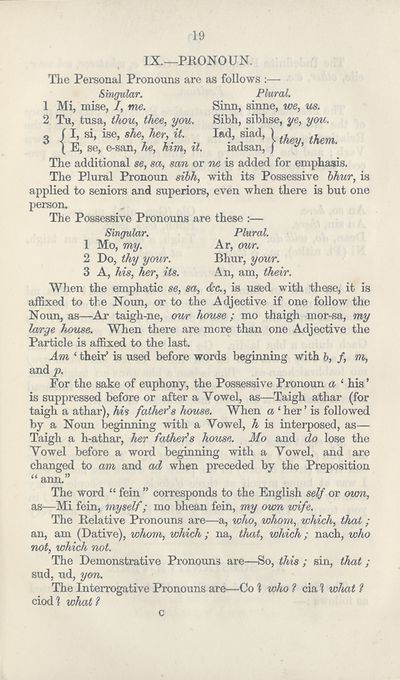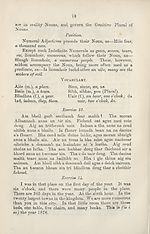Books and other items printed in Gaelic from 1871 to 1900 > Elementary lessons in Gaelic
(25) Page 19
Download files
Complete book:
Individual page:
Thumbnail gallery: Grid view | List view

19
IX.—PRONOUN.
The Personal Pronouns are as follows :—
Singular. Plural.
1 Mi, mise, /, me. Sinn, sinne, we, us.
2 Tu, tusa, thou, thee, you. Sibh, sibhse, ye, you.
3 j Mi, ise, she, her, it. lad, siad, ) ^^ ^^^
( ±j, se, e-san, he, him, it. laasan, ) ^'
The additional se, sa, san or ne is added for emphasis.
The Plural Pronoun sibh, with its Possessive hhur, is
applied to seniors and superiors, even when there is but one
person.
The Possessive Pronouns are these :—
Singular. Plural.
1 Mo, my. Ar, our.
2 Do, thy your. Bhur, your.
3 A, his, her, its. An, am, their.
WJien the emphatic se, sa, &c., is used with these, it is
affixed to the Noun, or to the Adjective if one follow the
Noun, as—Ar taigh-ne, our house ; mo thaigh mor-sa, my
large Jiouse. When there are more than one Adjective the
Particle is affixed to the last.
Am ' their' is used before words beginning with 6, /, m,
&nA p.
For the sake of euphony, the Possessive Pronoun a ' his'
is suppressed before or after a Vowel, as—Taigh athar (for
taigh a athar), hii fat/ier's house. When a ' her' is followed
by a Noun beginning with a Vowel, h is interposed, as—
Taigh a h-athar, her father's house. Mo and do lose the
Vowel before a word beginning with a Vowel, and are
changed to am and ad when preceded by the Preposition
" ann."
The word " fein " corresponds to the English self or oum,
as—Mi fein, myself; mo bhean fein, my own wife.
The Relative Pronouns are—a, who, whoin, which, that;
an, am (Dative), whom, which ; na, tlttct, which; nach, who
not, which not.
The Demonstrative Pronouns are—So, this ; sin, that ;
sud, ud, yon.
The Interrogative Pronouns are—Co ? who ? cia ? wJuit i
ciod? whaf^
0
IX.—PRONOUN.
The Personal Pronouns are as follows :—
Singular. Plural.
1 Mi, mise, /, me. Sinn, sinne, we, us.
2 Tu, tusa, thou, thee, you. Sibh, sibhse, ye, you.
3 j Mi, ise, she, her, it. lad, siad, ) ^^ ^^^
( ±j, se, e-san, he, him, it. laasan, ) ^'
The additional se, sa, san or ne is added for emphasis.
The Plural Pronoun sibh, with its Possessive hhur, is
applied to seniors and superiors, even when there is but one
person.
The Possessive Pronouns are these :—
Singular. Plural.
1 Mo, my. Ar, our.
2 Do, thy your. Bhur, your.
3 A, his, her, its. An, am, their.
WJien the emphatic se, sa, &c., is used with these, it is
affixed to the Noun, or to the Adjective if one follow the
Noun, as—Ar taigh-ne, our house ; mo thaigh mor-sa, my
large Jiouse. When there are more than one Adjective the
Particle is affixed to the last.
Am ' their' is used before words beginning with 6, /, m,
&nA p.
For the sake of euphony, the Possessive Pronoun a ' his'
is suppressed before or after a Vowel, as—Taigh athar (for
taigh a athar), hii fat/ier's house. When a ' her' is followed
by a Noun beginning with a Vowel, h is interposed, as—
Taigh a h-athar, her father's house. Mo and do lose the
Vowel before a word beginning with a Vowel, and are
changed to am and ad when preceded by the Preposition
" ann."
The word " fein " corresponds to the English self or oum,
as—Mi fein, myself; mo bhean fein, my own wife.
The Relative Pronouns are—a, who, whoin, which, that;
an, am (Dative), whom, which ; na, tlttct, which; nach, who
not, which not.
The Demonstrative Pronouns are—So, this ; sin, that ;
sud, ud, yon.
The Interrogative Pronouns are—Co ? who ? cia ? wJuit i
ciod? whaf^
0
Set display mode to:
![]() Universal Viewer |
Universal Viewer | ![]() Mirador |
Large image | Transcription
Mirador |
Large image | Transcription
Images and transcriptions on this page, including medium image downloads, may be used under the Creative Commons Attribution 4.0 International Licence unless otherwise stated. ![]()
| Rare items in Gaelic > Books and other items printed in Gaelic from 1871 to 1900 > Elementary lessons in Gaelic > (25) Page 19 |
|---|
| Permanent URL | https://digital.nls.uk/106251382 |
|---|
| Description | Out-of-copyright books printed in Gaelic between 1631 and 1900. Also some pamphlets and chapbooks. Includes poetry and songs, religious books such as catechisms and hymns, and different editions of the Bible and the Psalms. Also includes the second book ever published in Gaelic in 1631. |
|---|

